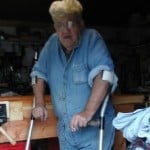How should I restore my Grandfather's Stanley No. 4?
Welcome! / Forums / General Woodworking Discussions / Tools and Tool Maintenance/Restoration / How should I restore my Grandfather's Stanley No. 4?
Tagged: Evapo-Rust, evaporust, plane, restoration, stanley
- This topic has 30 replies, 11 voices, and was last updated 5 years, 7 months ago by
donna.
-
AuthorPosts
-
5 August 2014 at 7:45 pm #60119
It’s definitely something I’d consider if I could scrounge a battery charger from a neighbour!
I presume that whatever derust method I choose, I should flatten the sole and sides as soon as possible after, then apply a thin coat of paste wax to stop further corrosion?
I’d wait to do any flattening until you were sure you needed to. My first restoration (also my granddad’s plane) resulted in removing way too much of the sole due to my own ignorance. Most planes need far less ‘work’ than people think. Planes do need to be flat around the mouth particularly, but not necessarily across the entire sole of the plane. Best to sharpen the iron and try it first. If it does need flattening, do it with the blade in and the cap properly tensioned (obviously retract the blade). I did my first flattening with just the body of the plane–and after I put it together–guess what? Not flat anymore. Fortunately, it works well as is–I won’t reflatten because there won’t be any sole left if I do! ‘Flat enough is good enough’ is a good philosophy here. The half-dozen planes I’ve done since then have required very little, if any flattening. Cleaning off the rust and sharpening the blade has been all that was needed to get good users.
BTW, if you’re going to try electrolysis, a plane like the #4 is a good first tool, as the parts will all submerse easily in a 5 gallon bucket. It won’t hurt any japanning or paint that is still there, which is a nice plus. And if you don’t like the results, you didn’t hurt anything, and you can still try something else.
d
7 August 2014 at 12:58 pm #60168@dcoons ok great – I’ll bare that in mind. I didn’t know that electrolysis didn’t affect the japanning as I’m sure I had seen one video where it stripped it. Perhaps they did that in another step.
Also do you think your issues could be you flattened while it was still disassembled? Perhaps having the item assembled creates necessary tension across the base that is important in this step?
I hope I can find some time this weekend to carry on restoring!
 16 August 2014 at 3:39 pm #61342
16 August 2014 at 3:39 pm #61342Hi Paul,
My recommendation from the planes that we restore at the workshop are that you will get most of the rust off with the flattening process, with abrasives and a soft wire brush. Most of the rust seems to be on the bottom and sides and on the blade, which all need attention anyway.
I would say that flattening the plane to some degree is important. I agree that it doesn’t have to be perfect, but it is a reference face whenever you plane your wood. It’s key to start by making sure everything is under correct tension. Here’s is a post Paul wrote for the flattening procedure with video:
http://paulsellers.com/2012/02/plane-soles-should-be-mostly-flat/
You can do the same on the sides, although getting them completely flat is not really necessary. It’s mostly to clean them up. Then you will want to take the frog apart, make sure it’s all clean and oiled, and flatten the area which the blade sits on, and a bit on the bottom of it where it comes in contact with the plane.
Then I would check the blade is roughly flat, and flatten the edge of the blade that the cap iron will sit on. I would probably make sure at least the first cm is flat. I would also flatten the cap iron where it contacts the blade to make sure there is no gap at the front edge when put together. For the freshly abraded surfaces, you could put some wax on (we use furniture wax) to help protect from rusting. We also use 3-in-1 oil whether by direct application and then wiping of the excess, or use the rag in a can on the working parts.
Here is Paul’s post on sharpening to finish off:
http://paulsellers.com/2012/02/sharpening-4-and-4-12-bench-planes/Then it’s just a matter of setting it and off you go!
Not having the plane assembled and under proper tension was absolutely the problem–but having said that, it’s best to sharpen the iron and give it a good go before messing with the sole. It’s usually not necessary. None of the other planes I’ve bought used and rusty needed more than cleanup and sharpening (lesson learned….). Unless something is really wrong, many planes don’t need any more than that.
27 October 2014 at 4:57 pm #120205So.. 2 months after starting, I’ve had some time to do some serious work this weekend. I’ve sanded, restrained, sealed then waxed the handle and knob. I got rid of the rust on the bolts and small parts by leaving in vinegar over night then scrubbing.
I’ve sanded off the rust from the iron, the cap, and the bottom sides. The end is in sight!
The only thing I’m not sure what to do with is the parts of the plane where the japanning has come off. I had originally decided to strip off all the japanning and repaint, but I can’t think of a suitable paint that would look good.
My question now is what would you do? Should I:
1) get rid of the rust, then oil/wax the bare metal and leave as is
2) patch over the bad parts with hammerite or something
3) completely strip the japanning and spray with somethingI’ve learned a hell of a lot from this project, including lots of mistakes I wouldn’t do again, but that’s all part of the process isn’t it 🙂
28 October 2014 at 3:51 pm #120272Just an update – I decided to just go for the hammerite smooth on a part that no-one would ever see.
It actually turned out GREAT! If you look and you know what you’re looking for you can see a slight difference with the hammerite versus the original japanning, but for the tiny patches I had to do it’s more or less seamless.
Got some float glass arriving tomorrow so hopefully I can finish up this week!
30 October 2014 at 7:57 pm #120358I usually start off with taking a single edge razor bladed to try and scrape off as much “dry rust” that you can.
I strip the plane and soak all the metal parts in Vinegar ( usually overnight ) then rinse and scrub off. I use a hair dryer to dry all the parts then proceed to 15, 220, 400, and maybe 600 grit wet / dry sandpaper. If there is still rust I repeat and usually that will be it.
I use an old rag with 3 – 1 oil and rub all over the plane, screw threads etc. Wipe off excess and then a couple coats of Johnston’s paste wax. I like to either just strip and wax the wood parts or sometimes I will use Tru – Oil that is used on Gun Stocks. I have restored a bunch of planes, chisels, hammers and saw’s with great results.
Steve
3 November 2014 at 7:42 pm #120480Yes I recently discovered just how effective plain vinegar is when getting rid of rust on the smaller parts.
Luckily we always have a 5 Litre tub of cleaning grade vinegar around!
One thing I did notice after scrubbing with some aluminium foil and soapy water after is that flash rust happens very quickly after. I hadn’t thought of using a hair drier to dry it off so that’s a good tip.
9 November 2014 at 3:18 pm #120740Okay! I am done.
So what did I do?
1. Strip down all parts and brush off any dust or shavings
2. Applied a few coats of Hammerite Rust Gel onto the plane sides & bottom, and the rusty iron and chip breaker
3. Washed gel off then sanded down at various grits to remote any trace of rust and bring back the shine
4. Put all the small metal pieces into vinegar, added some salt, and left over night
5. Dumped the small metal pieces into warm soapy water, scrubbed off surface rust then oiled
6. Touched up missing japanning using hammerite smooth
7. Sanded the old varnish and dye from the handles, re-stained, two coats of Liberon Spirit Sanding Sealer, then applied some Liberon Bison Wax using fine steel wool
8. Re-assembled the plane, then fettled the sole and sides on float glass with varying grades of wet & dry
9. Flattened the sole of the iron, then sharpened up
10. Polished out the iron cap using AutosolThere are several things I probably wouldn’t do again. For starters, I’d have tried paint/varnish removers on the handles to avoid having to aggressively sand them as much. I probably would have experimented with the electrolysis method of removing rust.
Attachments:
You must be logged in to view attached files. 9 November 2014 at 4:17 pm #120749
9 November 2014 at 4:17 pm #120749Paul that is a fantasic job you’ve done there ,i’m sure you’ll get a life times work out of that tool and then be able to pass it on, i’ve got a couple waiting to be done along with a couple of wooden planes. but i already have three done on my bench ,i didnt go as far as you did but they work fine and i get some nice work done with them enjoy using yours .
 10 November 2014 at 2:59 am #120771
10 November 2014 at 2:59 am #120771Hi Paul
You have been given a lot of good advise. Take your time it only needs to be done once. If you don’t like the elc. system you can use white vinegar soak 6 to 8 hours.
It will be a black gunk mess but it washes off. Oil if fast the parts will flash rust very fast.
This is true of what ever system you use. Have fun. There is a nice group here from all around the world that will try to help you. 11 November 2014 at 1:13 am #120812
11 November 2014 at 1:13 am #120812Holy Mackerel!! What a difference. That plane looks like new. The front knob looks spectacular. The steel of sole and sides is like new. I love the side-by-side pictures of pre- and post-restoration.
A job very well done, my friend. Now we want to hear about how well the shavings come out.
12 November 2014 at 11:11 am #120866@edfly – thanks for the praise! I wasn’t planning on doing such a complete restore, but during the process I realised how much fun it was so thought “why not do a full restore?!”.
@frankj – Yes I discovered just how good vinegar is on the smaller parts. I soaked them in the vinegar overnight, with a touch of added salt to accelerate the process. I still had to scrub a bit using tin foil (aluminium foil in the US?). It was very effective but I was amazed just how quickly flash rust appeared after washing. In future I’d dry off quickly using a hair drier.
@mattmcgrane – yes I’m particularly pleased with the front knob. The rear handle wasn’t as dark as I’d have liked, but I used the wood stain I had available to me at the time. I can’t believe how much of a difference two coats of shellac and a small amount of wax would do to the handles. They have perfect grip and feel incredible in the hand. I can’t offer any shaving images at the moment as the only vice I have is one that you mount to the top of a bench for metal work.I’d happily do this restoration again – in fact I’m looking for the next project!
-
AuthorPosts
- You must be logged in to reply to this topic.
